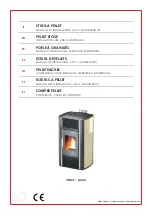
7
Roof pitch
? [°]
Horizontal width of
the zone of reflux
from the axis of the
ridge A[m]
Minimum height of
the outlet from the
roof Hmin
=Z+0.50m
Height of the reflux
zone Z [m]
15
1.85
1.00
0.50
30
1.50
1.30
0.80
45
1.30
2.00
1.50
60
1.20
2.60
2.10
Table 2
1.3 External air intake vent
•
The stove must have the air necessary to ensure smooth combustion operation and good environmental
well-being.
•
Make sure that the room where the stove is installed offers sufficient ventilation and install an air supply
duct from the outside with the recommended minimum section of 100 cm².
•
The air intake vent must communicate directly with the installation room of the stove, positioned so as to
prevent it from being blocked and protected with a permanent non-lockable grid or other suitable protection
provided that it does not reduce the minimum section.
•
Air flow can also be obtained from a room adjacent to the installation room, provided that this flow can be
carried out freely through permanent, non-closable openings communicating with the outside.
•
With respect to the installation room, the adjacent room should not be put under vacuum with respect to
the external environment as a result of a reverse draft caused by the presence in this space of another
utility device or suction device. The room adjacent to the permanent openings must meet the requirements
set out in the paragraphs above. The adjacent room cannot be used as a garage, for storage of
combustible material or for activities involving a risk of fire.
1.4 Connection to the chimney flue
(see paragraph 4.5)
1.5 Preventing house fires
Installation and use of the stove must be in accordance with the manufacturer's instructions and with local
habitability regulations.
CAUTION: when a fume exhaust pipe passes through a wall or ceiling, particular installation methods must
be applied (protection, thermal insulation, distances from heat sensitive materials, etc.).
•
The fireplace connecting tube must never pass through a combustible surface.
•
Do not connect this unit to a chimney flue already being used by another device.
•
It is also advisable to maintain all combustible elements or flammable material such as beams, wooden
furniture, curtains, flammable liquids, etc. outside the radiation area of the furnace and at a distance of at
least 1 m from the heating block. .
•
In the event that the surrounding space has coverings in combustible or heat-sensitive material, a
protective membrane made of non-combustible insulating material must be interposed. If the flooring is
made of combustible material, a non-combustible protective material that protrudes laterally and frontally
from 15cm to 30 cm must be provided at the mouth of the furnace.
•
For further information, refer to local requirements.








































